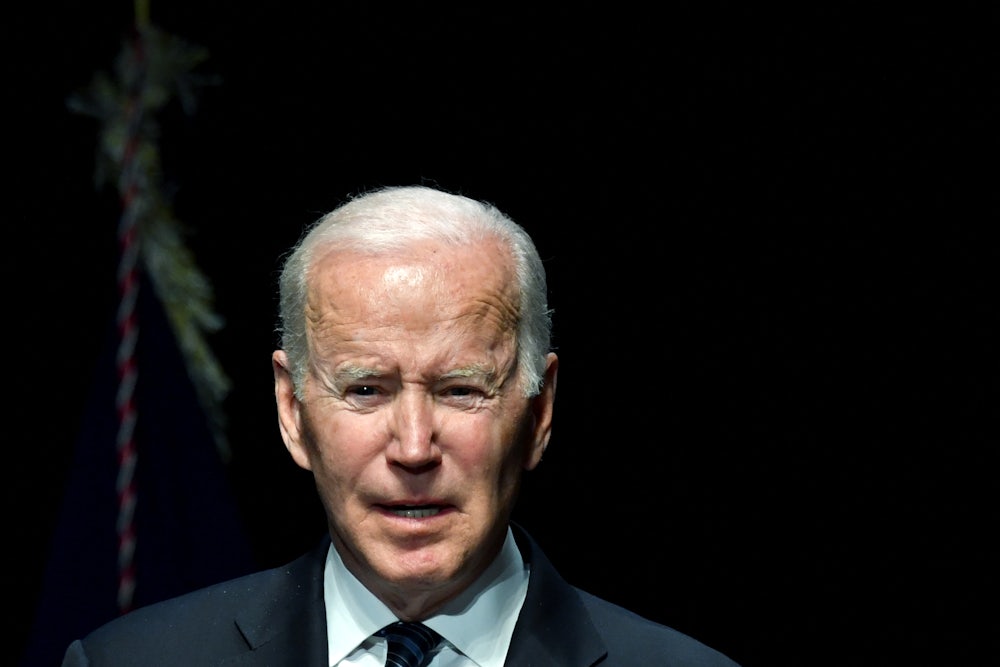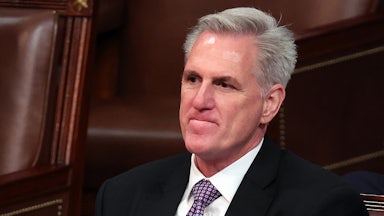Eight months ago, Representative Sean Patrick Maloney, who chairs the Democratic Congressional Campaign Committee, presented his colleagues with a dire warning: If the midterm elections were held right now, the Democrats would lose their thin majority—and their only hope of getting anything done in the two years leading up to the 2024 presidential election. Their best chance of winning? Getting stuff done.
At the time, Democrats signaled a willingness to face up to the facts and take the challenge head on. “We are not afraid of this data.… We’re not trying to hide this,” Tim Persico, the executive director of the DCCC, told Politico, referring to polls showing his party trailing the GOP by several points. “If [Democrats] use it, we’re going to hold the House. That’s what this data tells us, but we gotta get in action,” he added.
The Democrats have gotten some things done in the intervening months. They passed a bipartisan $1 trillion infrastructure package that contains a number of innovative ideas—it includes money to upgrade broadband infrastructure, modernize transit systems, and encourage the adoption of electric cars. But it also mostly does the thing infrastructure bills traditionally do: repair the country’s rusting bridges and pothole-infested roads. Its passage has done little for the Democrats’ electoral prospects or President Biden’s anemic popularity. Meanwhile, the party has been bogged down for months on the Build Back Better Act—a second spending package that now seems as unlikely to pass before the midterm elections as it did at the start of the year.
And so, with those midterm elections looming, they have turned to a new strategy: make the election about Donald Trump.
Per Politico, Biden and his advisers are “hoping to spend the spring and summer months drawing sharp distinctions with Republicans, one in particular.” Although they will continue to try to pass something—anything!—that shows voters that they deserve a another two years with majorities in both chambers, the message is shifting from “Look at what we’ve accomplished” to “Hey, at least we’re not a bunch of authoritarian crackpots.”
“This ain’t your father’s Republican Party,” Biden said at a rally late last month, before labeling the GOP “the MAGA party.” Trump, he argued, was the the Republican Party’s puppetmaster, forcing Republicans to stay in line with his corrupt and anti-democratic goals by threatening them primary losses. Democrats are pinning no small amount of hope, in addition, to the possibility that further revelations about the January 6, 2021, insurrection will boost Democrats’ electoral hopes as the January 6 commission’s work comes to a close.
In fairness to Democrats, their critique of the GOP is, strictly speaking, spot on. The Republican Party is increasingly authoritarian; Trump remains extremely powerful within it; and Republicans have spent most of the last 15 months making excuses for January 6, one of the ugliest events in recent American history. But as a political strategy, it reeks of desperation, especially given the Democrats’ stalled legislative agenda: As radical as Republicans may be and as untrustworthy with power as they are, there are reasons to believe that even stating these truths plainly will not yield the electoral results that Democrats hope they will.
Here’s one very obvious reason to doubt this plan: Donald Trump is quite literally not on the ballot. News coverage of the former president has waned considerably since he was kicked off Twitter last January, so most voters who aren’t already obsessed with the president haven’t been made to engage with his general lunacy on an hourly basis, as they were in the six years prior to January 6, 2021.
Incredibly, some within Bidenworld, per Politico, are actually hoping that Elon Musk’s pending takeover of Twitter will lead to the former president being reinstated, the theory being that it will be much easier to remind voters of Trump’s monstrous ideas and chaotic tendencies. But as boorish and repulsive as Trump is, it’s hard to believe that his Twitter presence will make a difference in the midterm elections. That is partly because Musk’s takeover may take months—if it happens at all. But it’s also because Republicans have a case of their own to make, particularly about Biden’s handling of the economy.
Biden’s long-running attempt at reaching out to centrists by labeling the GOP as not your “father’s Republican Party” has never achieved the results that he has hoped. Biden, moreover, has lost public support; his handling of the economy, in particular rampant inflation, has been a drag on his polling numbers. Naturally, Republicans do not have a plan to deal with inflation either. But throwing this back on the GOP, however justified it might be, is unlikely to convince many fence-sitting voters to vote for Democrats.
Similarly, turning out those who voted for Biden in 2020—particularly young voters and people of color—requires Congress to build an affirmative case for Democrats to remain in power. Biden hasn’t abandoned his voters completely: On the stump in 2020, he promised to reopen the country—a promise he has fulfilled, albeit with occasionally chaotic results. He also pledged to make post-Covid life better and more equitable. On that score, Democrats have done a woeful job, having been stymied by a handful of centrists within their ranks. A case for voting for Democrats in Congress must rest on actual results: not just whipping inflation but also beginning to make a dent in the laundry list of pledges that made up Biden’s platform. Failing that, the Democrats must demonstrate a commitment to these ideals by forcing the GOP to take tough votes against popular provisions—and frame them as the primary obstacle to progress.
The Democrats may be screwed either way—the party in power tends to sustain losses in the midterms—but that shouldn’t be an argument for sitting on their hands. This may very well be the party’s last chance to get anything done before 2024, meaning that it needs to get as much done as possible right now. Arguing that Trump and Republicans will make the country worse may be true, but it alone won’t save the Democrats. In fact, the strategy of figuratively putting Trump on the ballot in 2022 may only enable the real thing in 2024.










